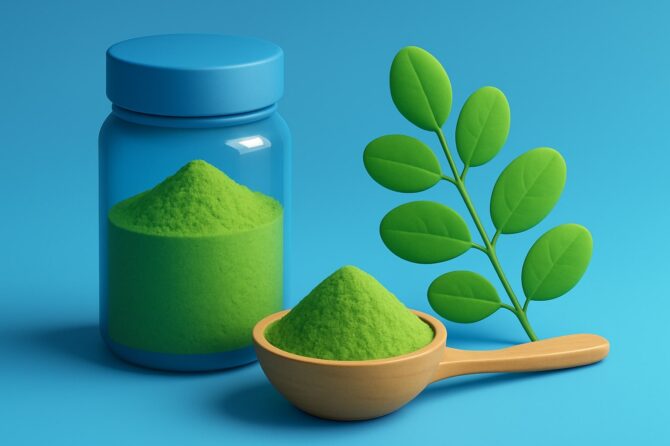
Moringa and Its Effects on Prostate Health: Exploration of Therapeutic Promise and Practical Applications
Abstract
Moringa oleifera, often referred to as the “miracle tree,” has garnered global attention for its extensive pharmacological and nutritional benefits. Among its various therapeutic domains, its potential role in supporting prostate health—particularly in mitigating risks related to benign prostatic hyperplasia (BPH) and prostate cancer—is increasingly becoming a subject of scientific inquiry.
Introduction
The prostate gland plays a central role in male reproductive health and undergoes various physiological changes with age. Pathological conditions such as BPH and prostate cancer affect millions of aging men worldwide. There is a pressing need for safe, affordable, and accessible phytotherapeutic interventions. Moringa oleifera, a tree native to South Asia and now cultivated globally, has shown anti-inflammatory, antioxidant, and hormonal modulatory effects—all of which are implicated in the pathophysiology of prostate disorders.
Bioactive Compounds Relevant to Prostate Health
The pharmacological potency of Moringa stems from its phytochemical richness:
- Isothiocyanates and glucosinolates – Chemoprotective agents linked to detoxification and inhibition of carcinogenesis.
- Flavonoids (quercetin, kaempferol) – Known for anti-inflammatory and antioxidant effects.
- Saponins and alkaloids – Potential for hormonal modulation and immune regulation.
- Polyphenols – Combat oxidative stress and inflammation, central in BPH and cancer progression.
- Beta-sitosterol – A phytosterol present in Moringa, already used in conventional BPH therapy.
These constituents contribute to Moringa’s proposed mechanisms in reducing prostate enlargement, inhibiting tumor proliferation, and improving urinary outflow.
Mechanisms of Action in Prostate Health
1. Anti-Androgenic Activity
Elevated dihydrotestosterone (DHT) levels contribute to prostatic hyperplasia. Studies in animal models show that Moringa leaf extract may inhibit 5-alpha reductase, the enzyme responsible for DHT synthesis, paralleling the mechanism of pharmaceuticals like finasteride.
2. Anti-Proliferative and Apoptotic Effects
In vitro studies (e.g., on PC-3 and LNCaP prostate cancer cell lines) suggest that Moringa seed extract induces apoptosis in malignant cells while sparing normal tissue. This is largely attributed to isothiocyanates and phenolic compounds.
3. Anti-Inflammatory Properties
Chronic inflammation is a key driver of both BPH and prostate cancer. Moringa’s high flavonoid content suppresses NF-κB and COX-2 expression, reducing pro-inflammatory cytokines such as TNF-α and IL-6.
4. Antioxidant Defense
Oxidative stress damages prostatic DNA and facilitates malignancy. Moringa enhances superoxide dismutase (SOD), catalase, and glutathione peroxidase activity in prostate tissue, thereby reducing oxidative DNA damage.
5. Hormonal Modulation
Some animal studies indicate that Moringa may help regulate estrogen:testosterone ratios, which could have implications for age-related prostate enlargement and hormonal balance.
Urinary Benefits
A common complication of BPH is lower urinary tract symptoms (LUTS)—frequent urination, incomplete bladder emptying, urgency, and nocturia. Moringa’s benefits in urinary health are attributed to:
- Relaxation of smooth muscles in the bladder and urethra.
- Diuretic effects promoting better urine flow.
- Anti-inflammatory action reducing urethral swelling and irritation.
In experimental studies on BPH-induced rats, Moringa extract led to improved bladder emptying and reduced residual urine volume.
Ingestion Methods and Dosage
Moringa can be consumed in various forms, each with distinct bioavailability:
1. Powdered Leaves
- Widely available and rich in antioxidants.
- Dose: 2–6 grams/day mixed in water, smoothies, or capsules.
2. Aqueous Extracts (Teas)
- Mild concentration; better tolerated for long-term use.
- Infusion from 1–2 teaspoons dried leaves per cup.
3. Ethanolic Extracts (Tinctures)
- Concentrated form, often used in experimental studies.
- May offer superior bioavailability of certain polyphenols.
4. Seed Oil or Crushed Seeds
- Rich in fatty acids and isothiocyanates.
- Less commonly used due to bitter taste and potency concerns.
5. Capsule Form
- Convenient and standardized; best for therapeutic dosing.
- Dosage ranges between 500 mg–1000 mg twice daily.
Note: Long-term safety at high doses is still under research. Caution is advised when combining with prostate medications or hormone therapy.
Safety and Contraindications
- Generally regarded as safe in moderate amounts.
- Possible interactions with anticoagulants, diuretics, and antihypertensives.
- High doses may lead to gastrointestinal discomfort or hypoglycemia.
Miscellaneous Findings and Emerging Research
- Epigenetic Modulation: Preliminary studies suggest Moringa may influence gene expression related to tumor suppression.
- Microbiome Interaction: Moringa polysaccharides may foster gut flora that indirectly affect systemic inflammation and hormonal metabolism.
- Synergistic Effects: Combination with zinc, selenium, or saw palmetto may enhance efficacy in BPH therapy.
Limitations of Current Research
- Majority of data derived from animal studies or in vitro models.
- Human clinical trials are scarce, though anecdotal use is widespread.
- Lack of standardized extraction methods across studies.
Conclusion
Moringa oleifera presents a promising, multifaceted phytotherapeutic agent for supporting prostate health and urinary function in aging men. Its anti-androgenic, antioxidant, and anti-inflammatory properties make it a candidate for integrative urology. However, rigorous clinical trials in humans are needed to confirm efficacy, determine optimal dosage, and identify long-term safety outcomes. Until then, Moringa should be viewed as a complementary—not primary—intervention for prostate support.
Leave a reply

Leave a reply